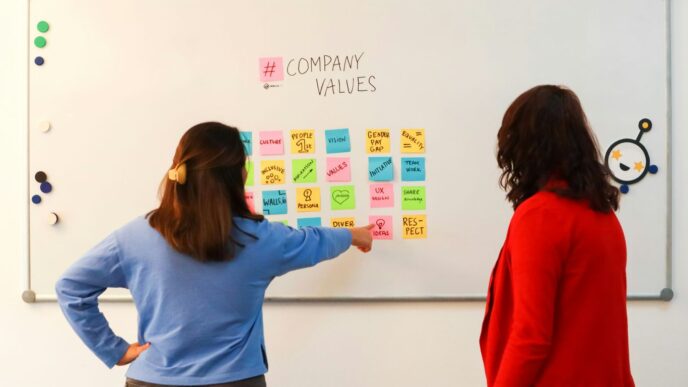The business world is changing fast, and AI is a big part of that. For 2026, it’s not just about using AI to save money. It’s about using it to grow and find new ways to do things. This means leaders need to think differently, teams need new skills, and companies need smart plans to stay ahead. Let’s look at how businesses can use AI for success.
Key Takeaways
- Businesses should shift their focus from just cutting costs with AI to using it for growth and finding new opportunities. This means investing in AI capabilities that can expand market reach and create new revenue streams.
- Leaders in 2026 will need to manage teams where people and AI work together. This requires understanding both human and AI strengths, and building a culture that supports continuous learning and ethical AI use.
- AI agents will start handling complex tasks, and AI-powered products will solve customer problems in new ways. Companies that create these will stand out.
- The workforce needs to adapt. Upskilling and reskilling employees for the AI era is important, but so are human skills like creativity and communication, which become more valuable when AI handles routine tasks.
- A smart AI strategy means redesigning how services are delivered and making AI accessible across the company. This approach can lead to much bigger gains than just automating existing jobs.
Embracing AI For Business Growth
It’s time to rethink how we look at Artificial Intelligence in business. For a while now, the main focus has been on using AI to cut costs, which makes sense, right? Save money where you can. But that’s starting to feel a bit old-fashioned. The real game-changer for 2026 and beyond isn’t just about being cheaper; it’s about using AI to grow in ways we couldn’t before.
Shifting From Cost Reduction To Growth Enablement
Think about it: if everyone is just using AI to trim expenses, you’re just keeping pace. The companies that will really stand out are the ones using AI to find new customers, create new products, or enter new markets. This isn’t about doing the same old jobs for less; it’s about doing entirely new things that weren’t possible before. Imagine AI helping you design products that customers actually want, or reaching customers in places you never thought you could. That’s where the big wins are going to be.
The Compound Effect Of Growth-Oriented AI
When AI helps you grow, it creates a kind of snowball effect. More customers mean more information, which makes the AI smarter. A smarter AI can then help you reach even more customers or provide better service. It’s a cycle that just keeps building on itself. Early investments in AI capabilities don’t just pay off once; they keep paying dividends as they get better and enable more growth.
Here’s a look at how that cycle can work:
- Market Expansion: AI tools help identify and reach new customer segments or geographic areas.
- Data Accumulation: Increased customer interactions generate more data.
- AI Improvement: More data leads to better AI performance and insights.
- Enhanced Offerings: Improved AI allows for new or better products and services.
- Further Growth: These enhanced offerings attract more customers, restarting the cycle.
Strategic Investment In AI Capabilities
So, how do you actually make this shift? It starts with how you invest. Instead of asking, "How much money can AI save us?" leaders need to ask, "What new opportunities can AI help us seize?" This means looking at AI not just as an efficiency tool, but as a strategic partner for expansion. It requires a longer-term view, understanding that building these growth capabilities takes time and consistent effort. It’s about building a foundation that allows for continuous innovation and market leadership, rather than just incremental cost savings.
Redefining Leadership In The Age Of Augmented Working
Okay, so 2026 is shaping up to be a wild ride, especially when it comes to how we lead. Forget just managing people; we’re talking about leading teams where humans and AI are working side-by-side. It’s a whole new ballgame.
Managing Human-AI Collaboration
This isn’t about replacing people with robots. It’s about figuring out how to make humans and AI work together effectively. Think of it like a band – you need the drummer, the guitarist, and the singer, all playing their part. Leaders need to know what AI is good at (crunching numbers, finding patterns fast) and what humans are good at (creativity, understanding feelings, making tough judgment calls). The goal is to build teams where each part makes the other stronger.
Here’s a quick look at what that means:
- AI Strengths: Speed, data processing, repetitive tasks, pattern recognition.
- Human Strengths: Empathy, creativity, complex problem-solving, ethical judgment, adaptability.
- Collaboration Focus: Designing workflows where AI handles the heavy lifting, freeing up humans for higher-level thinking and customer interaction.
Fostering Lifelong Learning And Ethical AI Use
Leaders have a big job here. They need to create a company culture where everyone is always learning. The tech changes so fast, you can’t afford to stand still. This also means making sure everyone understands how to use AI the right way – ethically. We don’t want AI making biased decisions or being used for shady stuff. It’s about building trust, both internally and with customers.
- Continuous Learning: Encourage training, workshops, and self-study for new AI tools and skills.
- Ethical Guidelines: Develop clear rules for AI use, covering data privacy, fairness, and transparency.
- Open Dialogue: Create spaces for employees to discuss AI’s impact and ethical concerns.
Empowering Human Workers For Customer-Centric Experiences
With AI taking over some of the grunt work, human employees can focus on what they do best: connecting with customers. This means giving them the tools and the freedom to really understand what customers need and provide amazing service. It’s about making sure that even with all this tech, the human touch remains central to the business. Think about it – when you have a problem, sometimes you just want to talk to a real person who gets it. That’s the experience we’re aiming for.
AI Agents And AI-Enabled Products
Okay, so let’s talk about AI agents and products. This isn’t just about making things faster, though that’s part of it. We’re looking at how AI can actually help businesses grow and create new things. Think of AI agents as super-smart assistants that can handle a whole bunch of tasks on their own. They can manage invoices, sort out payments, or even help onboard new employees. This frees up people to do more interesting work, the kind that really needs a human touch.
Automating Complex Business Processes With AI Agents
AI agents are getting pretty good at handling multi-step jobs without much help. Imagine your finance department. An AI agent could track down overdue invoices, process payments, and reconcile accounts all by itself. In HR, it could manage the whole new hire process, from paperwork to setting up training. This means fewer mistakes and a lot more time for your team to focus on strategy or talking to customers. It’s like having a whole team of tireless workers who never need a coffee break.
Developing Innovative AI-Powered Products And Services
This is where things get really exciting. Businesses aren’t just using AI to run better; they’re building AI into their products and services. We’re talking about things like AI co-pilots for your software, tools that help design new products, or even smart appliances that learn your habits. The companies that are ahead of the curve aren’t just good at using AI themselves; they’re helping their customers use it too. It’s a whole new way to solve problems.
Solving Customer Problems In New Ways With AI
So, how does this actually help customers? Well, instead of just getting a faster response, they might get a product that’s perfectly tailored to them, or a service that anticipates their needs before they even ask. Think about a streaming service that suggests shows you’ll actually love, or a smart home device that adjusts your environment based on your mood. These AI-driven solutions create experiences that were just not possible before. It’s about making life easier and more personalized for everyone.
The AI Skills Dividend And Workforce Evolution
It’s not just about having AI tools; it’s about having people who know how to use them to actually grow the business. For a while, everyone was talking about how AI could cut costs by automating jobs. That’s still part of the picture, sure, but the real win in 2026 is seeing AI as a way to do things we couldn’t do before. Think about it: AI can help us find new customers, create new products, or even enter markets that were just too expensive to consider previously. This shift from just cutting costs to actively enabling growth is where the big payoff is.
But this doesn’t happen by accident. Companies that are doing this well are investing in their people. They’re not just hiring AI experts; they’re teaching everyone how to work with AI. This means a lot of upskilling and reskilling. It’s like learning a new language, but instead of French, it’s about understanding how to prompt an AI effectively or how to interpret the data it gives you.
Here’s a quick look at what that means:
- Learning New Tricks: Employees need training not just on how to operate AI tools, but on how to think differently about their work. This includes understanding AI’s limits and its strengths.
- Human Strengths Matter More: While AI handles the repetitive stuff, the skills that make us human – like creativity, critical thinking, and empathy – become even more important. These are the things AI can’t easily replicate.
- Working Together: The future workplace isn’t just humans or AI; it’s humans and AI. Figuring out how to make that partnership work smoothly is key. This might mean changing how teams are structured or how projects are managed.
Companies that get this right aren’t just staying afloat; they’re building a real advantage. Their people get better at their jobs with AI’s help, and the company as a whole becomes more capable. It’s a cycle that keeps building on itself, making it harder for others to catch up.
Strategic AI Implementation For Competitive Advantage
Beyond Use-Cases: Redesigning Service Delivery Models
Forget just finding little ways to make things faster. The real game-changer with AI isn’t about tweaking existing processes; it’s about rethinking how we deliver value entirely. Think about it: instead of just automating a few tasks, what if we rebuilt our entire service model around what AI can do? This means looking at how humans and AI can work together to create something entirely new, something that wasn’t even possible before. It’s about shifting from just fixing problems to creating new opportunities.
Democratizing AI Across The Organization
Making AI available to everyone in the company is key. It’s not just for the tech wizards in a back room. When every employee can access and use AI tools, they can find new ways to help customers or improve their own work. This spreads the benefits of AI far and wide, not just to a select few. It’s like giving everyone a superpower.
Achieving Exponential Returns Through AI
Companies that really get AI aren’t just saving money; they’re growing way faster than they could before. This happens because AI can handle more and more work without costs going up as much. It’s like a snowball rolling downhill – the bigger it gets, the faster it grows. This creates advantages that are really hard for others to catch up with.
Here’s a look at how this growth can stack up:
- Market Expansion: AI allows businesses to enter new markets or serve more customers without needing a proportional increase in staff or resources. This opens up revenue streams that were previously out of reach due to cost.
- Product Innovation: With AI handling routine tasks, teams can focus on developing new products and services that offer unique value, differentiating the company from competitors.
- Customer Experience: AI can help personalize interactions and provide faster, more consistent support, leading to happier customers and increased loyalty.
The real AI advantage comes from using it to grow boldly, not just to survive by cutting costs.
Navigating Economic Shifts With AI
The economic climate can feel like a rollercoaster, right? One minute things are humming along, the next, you’re bracing for impact. In 2026, businesses need to be ready for these ups and downs, and AI is a big part of that preparation. It’s not just about cutting costs anymore; it’s about finding new ways to grow, even when things get a bit shaky. Think of AI as your co-pilot, helping you spot opportunities you might otherwise miss.
Adapting To Global Economic Fluctuations
Economic shifts are happening faster than ever. AI can help us keep up. It can analyze vast amounts of data to predict market changes or identify supply chain risks before they become major problems. This means you can react quicker, maybe by adjusting inventory or finding alternative suppliers. It’s about building resilience into your operations. For instance, AI can help model different economic scenarios, showing you potential outcomes and how your business might fare. This kind of foresight is invaluable when planning for the unexpected. We’re seeing AI agents start to manage complex tasks, which can free up human workers to focus on these more strategic, adaptive roles. This is a key trend for 2026 business shifts.
Identifying Growth Opportunities Amidst Challenges
When the economy is tough, it’s easy to just focus on survival. But that’s also when the biggest opportunities often appear. AI can help uncover these hidden gems. By looking at customer behavior data in new ways, AI might reveal unmet needs or underserved markets. This could lead to developing new products or services that competitors haven’t thought of. It’s about using AI to expand your reach, not just to trim expenses. The goal is to create new revenue streams that weren’t possible before.
Here’s how AI can help find those opportunities:
- Market Analysis: AI can sift through market data to pinpoint emerging trends and consumer demands.
- Customer Insights: Analyzing customer interactions can reveal pain points that your business can solve.
- Operational Efficiency: Automating routine tasks frees up resources for innovation and market exploration.
- New Product Development: AI can assist in designing and testing new offerings based on predicted market needs.
Pivoting Towards Innovation With AI
Sometimes, the best way to handle economic uncertainty is to innovate. AI isn’t just a tool for efficiency; it’s a catalyst for creativity. Businesses that embrace AI can redesign their entire service models, creating unique value propositions. Instead of just improving existing processes, think about how AI can enable entirely new ways of doing business. This might involve creating AI-powered products that solve customer problems in ways never before imagined. The key is to view AI not as a replacement for human effort, but as a partner that amplifies human ingenuity. This shift from just optimizing to truly transforming is where the real competitive advantage lies.
Looking Ahead: Your AI Growth Plan
So, as we wrap up, it’s pretty clear that AI isn’t just some tech fad anymore. It’s really changing how businesses work, and by 2026, it’s going to be even more central. We’ve talked about how using AI just to cut costs isn’t the big play; it’s about using it to find new ways to grow, to do things that weren’t even possible before. Think about how AI can help you reach more customers or create totally new products. It’s a big shift, for sure, and it means leaders need to think differently about where they put their money and how their teams work. The companies that really lean into this, that see AI as a partner for expansion rather than just a tool for saving a buck, are the ones that are going to pull ahead. It’s not just about keeping up; it’s about building something bigger and better for the future.
Frequently Asked Questions
Why should businesses focus on using AI for growth instead of just saving money?
Think of it like this: saving money is good, but making more money is even better! When businesses use AI to find new customers, create cool new products, or reach more people, they grow. This growth can then help them make even more money in the future, creating a cycle of success that’s way more exciting than just cutting costs.
What does it mean for leaders to ‘manage augmented teams’?
It means leaders have to guide teams where both people and smart computer programs (AI) work together. Leaders need to understand what people are good at (like being creative or understanding feelings) and what AI is good at (like crunching numbers fast). They also need to help everyone learn how to use AI the right way, making sure people are still at the center of everything.
How can AI agents help businesses?
AI agents are like super-smart assistants that can do whole jobs on their own, like managing customer orders or sending out bills. By letting AI agents handle these tasks, people in the company have more time to focus on creative ideas, talking to customers, or solving bigger problems that need a human touch.
Why is learning new skills important for workers in the age of AI?
As AI takes over some jobs, people need to learn new skills to work alongside it. This means learning how to use AI tools, but also getting better at things AI can’t do, like being creative, solving tricky problems, and connecting with people. Learning these skills helps people stay valuable and find new opportunities.
How can companies use AI to get ahead of their competitors?
Instead of just using AI to do the same old tasks faster, smart companies are using it to do things they never could before. This might mean creating brand new products, reaching customers in new places, or offering amazing services that others can’t match. It’s about using AI to be different and better, not just cheaper.
What should businesses do when the economy is unpredictable?
When the economy is shaky, businesses need to be flexible. This means being ready to change plans quickly, finding new chances to grow even when things are tough, and using AI to come up with fresh ideas. It’s like being a surfer – you need to know how to ride the waves, even when they’re big and unpredictable.














